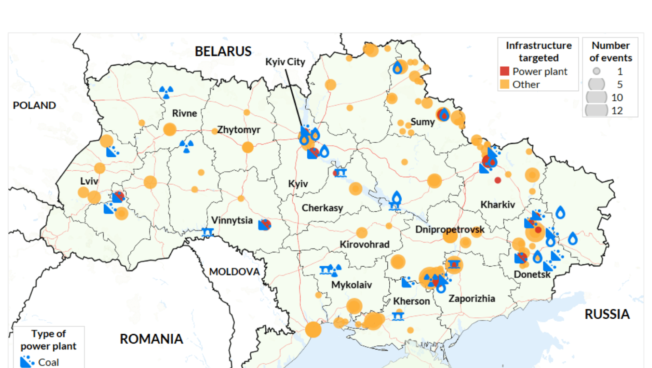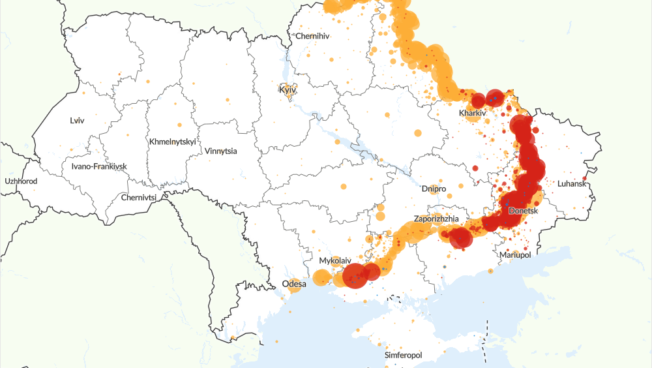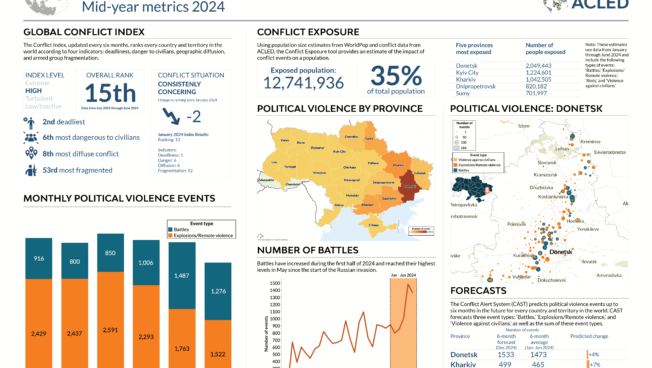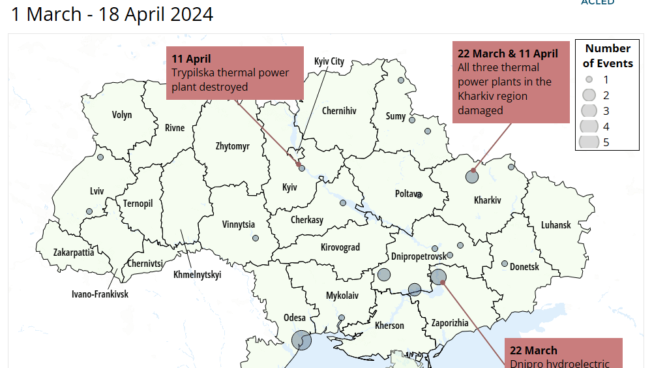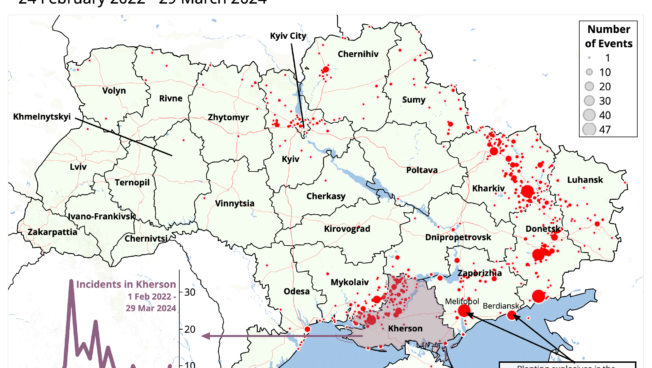Last updated: 7 May 2025
Amid the ongoing war in Ukraine, this aerial photograph shows the destruction in the village of Bohorodychne in the Donetsk region on 27 January 2024. Photo by Roman Pilipey/AFP via Getty Images
ACLED’s Ukraine Conflict Monitor provides near real-time information on the ongoing war, including an interactive map of the latest data from the start of Russia’s invasion, a curated data file, and weekly situation updates. It is designed to help researchers, policymakers, media, and the wider public track key conflict developments in Ukraine. It is released every Wednesday, with data covering events from Saturday to Friday of the preceding week and providing updates to past events as new or better information becomes available.
Ukraine war situation update
26 April – 2 May 2025
Key trends
- Russian forces occupied four settlements in total: one southwest of Pokrovsk, another south of Kramatorsk, and one more north of Lyman in the Donetsk region, in addition to a settlement east of Borova in the Kharkiv region.
- ACLED records at least 29 Russian long-range missile and drone strikes, including in the Kyiv region and Kyiv city, the northern region of Zhytomyr, and the central regions of Poltava and Kirovohrad.
- Russian shelling, missiles, aerial bombs, and drones killed at least 32 civilians in the Chernihiv, Dnipropetrovsk, Donetsk, Kharkiv, Kherson, Odesa, Sumy, and Zaporizhia regions. Ukrainian shelling and drone strikes reportedly killed four civilians in occupied Horlivka in the Donetsk region.
Key events
- 1 May | Zaporizhia – Russian drones strike residential buildings in Zaporizhia city, killing one civilian and wounding 33
- 1 May | Odesa – Russian drones hit civilian infrastructure in Odesa city, killing two civilians and wounding 15
- 2 May | Kharkiv – Russian drones wound over 50 civilians in Kharkiv city
Spotlight: A suspected Russian intelligence agent attempts to kill an activist in Kyiv city
On 1 May, a woman reportedly recruited by Russian intelligence1Security Service of Ukraine, “SBU issued a notice of suspicion to the attacker on well-known volunteer and activist Serhiy Sternenko (video),” 2 May 2025 (Ukrainian) shot Serhii Sternenko outside his apartment in Kyiv city. He sustained a non-life-threatening injury; police detained the woman. Sternenko has been a prominent pro-Ukrainian activist since 2014 and one of the largest private suppliers of drones for the Ukrainian military — his charitable foundation has purchased over 176,000 drones since February 2022.2Kateryna Denisova, “Ukrainian activist, volunteer Sternenko injured in attack, suspect detained,” The Kyiv Independent, 6 May 2025 The assassination attempt was likely meant to coincide with the 11th anniversary of the Odesa Trade Union building fire3Yaroslava Tymoshchuk, “Attempted murder of Sternenko: why are there attacks on activists in Ukraine and what does Russia have to do with it?” Radio Free Europe, 2 May 2025 (Ukrainian), when pro-Ukrainian football fans set ablaze an encampment of pro-Russian activists following an ambush and clashes. The fire killed 42 people, in addition to six people who were killed by firearms.4United Nations, “7 years with no answers. What is lacking in the investigations of the events in Odesa on 2 May 2014?” 30 April 2021 In a recent judgment, the European Court of Human Rights condemned Ukrainian authorities for failing to stop the outbreak of violence, rescue people trapped inside the building, and conduct an effective investigation.5European Court of Human Rights, “Judgment concerning Ukraine,” 13 March 2025 Sternenko, then the head of the local branch of the nationalist Right Sector party, was one of the several thousand pro-Ukrainian participants in the 2014 clashes in Odesa, which Russia frequently propagandizes to dehumanize pro-Ukrainian activists.6Meduza, “The making of a myth. How Russian media uses a 2014 fire in Odesa to justify the war on Ukraine,” 8 May 2024 Since then, he actively protested against illegal construction in Odesa, advocated for police reform, and disrupted concerts of Russian and pro-Russian artists.7Sonya Lukashova, “Maidan, drugs, Avakov and other wars of Serhiy Sternenko,” Ukrainska Pravda, 19 May 2020 (Ukrainian) In 2018, Sternenko survived three attacks and accused the local Odesa authorities of being behind them.8New Voice, “Three attacks on Serhiy Sternenko. What is known about the ex-head of the Odesa Right Sector,” 30 May 2018 (Ukrainian) Two years after the last of these attacks, Sternenko was charged with killing one of his attackers, which led to a trial that was discontinued in December 2023.9Oleksandr Kunytskyi, “Attack on Sternenko: activist underwent surgery,” Deutsche Welle, 1 May 2025 (Ukrainian)
The recent attack on Sternenko is one of dozens of similar incidents reported in both Ukraine and Russia since the start of the war in 2022. On 14 March, an AWOL Ukrainian soldier shot dead an activist and volunteer in Odesa. Meanwhile, throughout April, car explosions killed the Ukrainian head of the Left Bank Administration of the Dnipro City Council, a Russian general in Moscow, and the head of a Russian design bureau working on developing electronic warfare for suppressing drones and his assistant in Bryansk.
Explore the ACLED Conflict Exposure tool to assess the numbers of people affected by armed violence, disaggregated by locations, time period, and actors involved.
Ukraine Conflict: Interactive Map
This interactive map includes political violence events in Ukraine since the start of the Russian invasion on 24 February 2022.
Date and subset filters
By default, the map displays data for the most recent week. Use the date filters to change the date range in view.
Use the subset filters to analyze trends in more detail.
Changing view
By default, the map is set to event view, which uses scaled circles to show events at a given location. Click on a region in Ukraine to zoom in for a more detailed view. Hovering over a region will give a count of events within its borders.
Changing to region (oblast) view will switch the map to a choropleth, giving an overview of event density per region. This will also disable the zoom function.
Events in Russia
While in event view, use the ‘Events in Russia’ toggle to show or hide conflict-related events in Russia. Conflict-related events are identified as follows:
- All events with the ‘Battles’ or ‘Explosions/remote violence’ event type.
- Events with the ‘Violence against civilians’ event type, where the actor is:
- Ukrainian or Russian military
- Russian border guards
- Pro-Ukrainian Russian militias
Attacks on Ukranian infrastructure
ACLED uses four automatically generated infrastructure tags when coding events that occur in Ukraine, each covering a vital sector that focuses on civilian infrastructure: energy, health, education, and residential infrastructure.
For more information, read our methodology explainer.
Event counts and civilian fatalities
The box in the bottom right hand corner displays event counts in total, disaggregated by event type, and filtered by date or subset according to the options already selected.
It also shows a conservative estimate of civilian fatalities, limited to events where civilians are targeted directly. Military casualties are not represented on the map as they are largely unverifiable.
For more information on how ACLED codes fatalities, read our methodology explainer.
Curated Data
This file contains all political violence events, demonstration events, and strategic developments recorded in Ukraine and the Black Sea from the beginning of ACLED coverage in 2018 to the present.
For an overview, see our interactive dashboard.
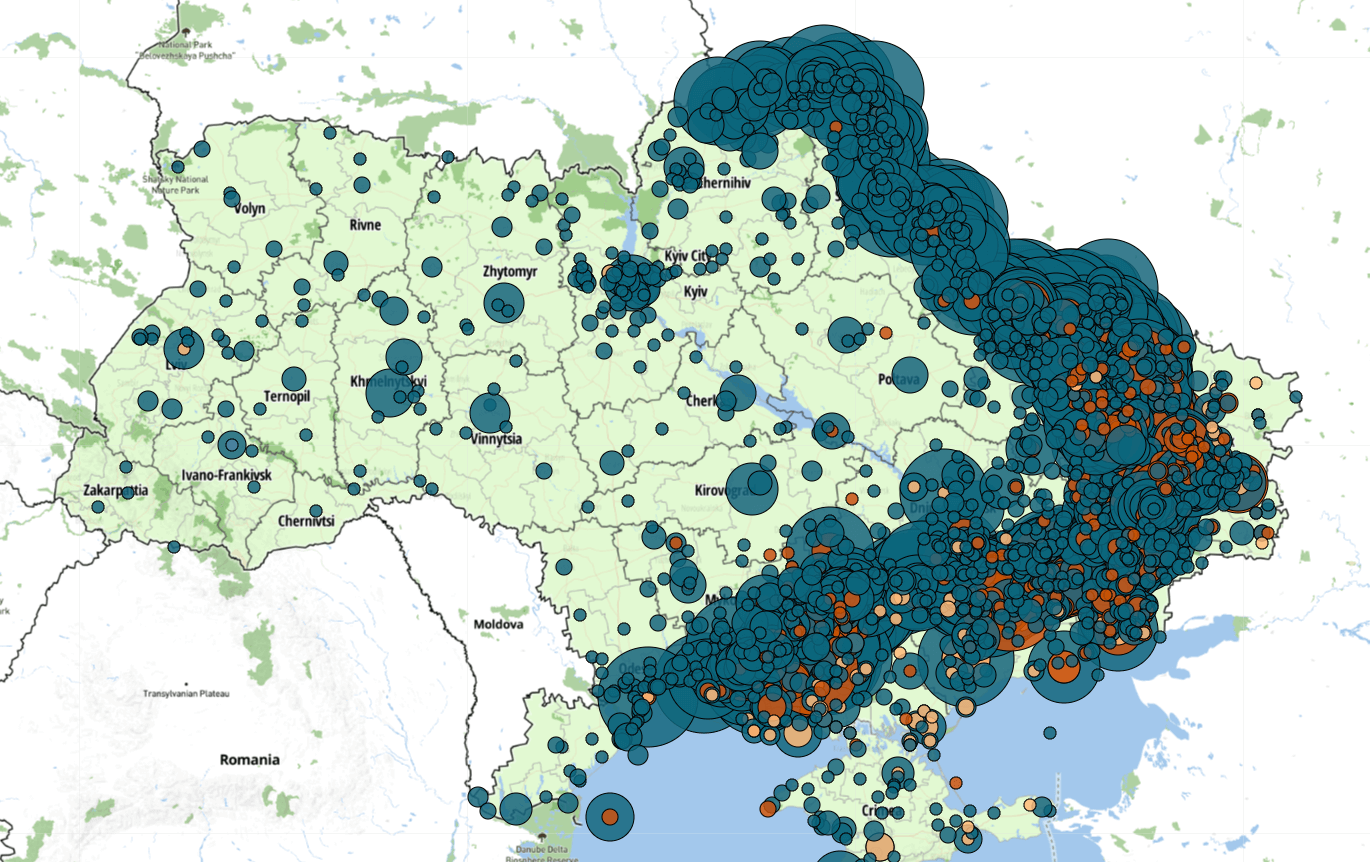
Ukraine & the Black Sea ( 02 May 2025 )
Attacks on Ukranian infrastructure
ACLED uses four automatically generated infrastructure tags when coding events that occur in Ukraine, each covering a vital sector that focuses on civilian infrastructure: energy, health, education, and residential infrastructure. This file contains all events featuring one or more of these tags.
For more information, read our methodology note.
Sign up for Ukraine Conflict Monitor updates
Information & Analysis
For additional information on the conflict in Ukraine, check our analysis of political violence trends from the start of ACLED coverage in 2018.

